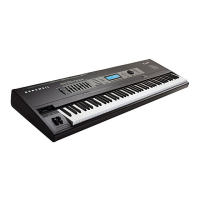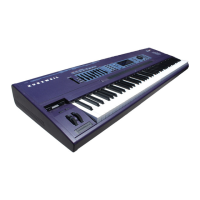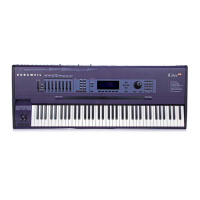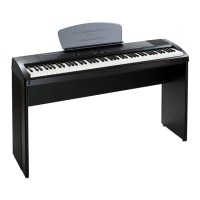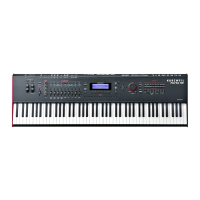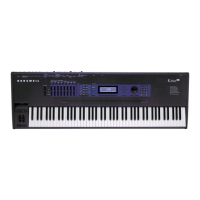6-16
Program Mode
Editing VAST Programs
Timbre Shift
This parameter works only on multi-sample keymaps, and changes the root selection for each
key you play. With this parameter you can radically alter the current layer’s timbre (basic sound
characteristics). The nature of the change depends on the timbre itself, so this parameter calls for
experimentation. Basically, timbre shifting changes a note’s timbre by imposing dierent
harmonic qualities onto the note. A timbre-shifted note retains its original pitch, but its
harmonics are those of the same timbre at a higher or lower pitch. Positive values for this
parameter tend to brighten a sound, while negative values darken.
Here’s an example. If you shift the timbre up 4 semitones, then playing C 4 will result in the pitch
C 4, but will actually play the sample normally assigned to G
#
3, and shift its pitch up four
semitones. This will increase the playback rate of the sample, so although the pitch remains
normal, the timbre is brighter. You’d get the same eect by setting the Xpose parameter on the
KEYMAP page to -4 semitones, then setting the Adjust on the PITCH page to +4 semitones. For
multi-sample layers with narrow key ranges, large amounts of timbre shifting will cause
dierent sample roots to be played back.
Playback Mode
This gives you numerous options for manipulating the samples in the current layer as you trigger
them. Normal leaves the samples unaected, while Reverse plays them in reverse. At a value of
Reverse, the samples will continue to loop as long as notes are sustained. To play them just once
in reverse, you would adjust the length of the layer’s amplitude envelope (explained later in this
chapter). BiDirect (bidirectional) causes the samples to loop innitely, alternating between
normal and reversed playback. Noise replaces the samples with a white noise generator.
Alternative Controller (AltControl)
See Alternative Switch (AltControl and AltMethod) below.
Alternative Switch (AltControl and AltMethod)
Many, but not all, PC3A sample roots have been pre-assigned a carefully chosen alternate sample
start point that can be selected using the Alternate Switch feature (AltControl and AltMethod
parameters). This feature allows you to control the sample playback start/end time triggered by
any control source. (The alternate sample start point can be adjusted by editing a sample, see
Editing Samples on page 14-9 and The TRIM Page on page 14-12 for details.)
Use the AltControl parameter to specify a control source that will cause the sample to begin or
end at the Alt point. Then use the AltMethod parameter to choose between switched and
continuous calculation of the Alt point. If the value of AltMethod is Switched, the PC3A will use
the Alt point when the relevant control source is at a value greater than 64 at Note Start. If
AltMethod is Continuous, the Alt point will vary depending on the value of the relevant control
source at Note Start.
As an example, suppose you’re working with a ute keymap and wish to control the amount of
chi heard at the beginning of the sound. On the KEYMAP page in the Program Editor, set
AltControl to MWheel. Now the Mod Wheel controls how much of the initial sample attack is
used. If you set AltMethod to Switched and move the Mod Wheel at least half-way up, at Note
Start the sample will begin at the pre-set alternate start point (in this case, slightly past the initial
chi). If you set the AltMethod to Continuous, the PC3A will interpolate the sample’s starting
point based on the position of the Mod Wheel. If the Mod Wheel is 75% of the way up at Note
Start. the sample will begin 75% of the way between normal and alternate start points.

